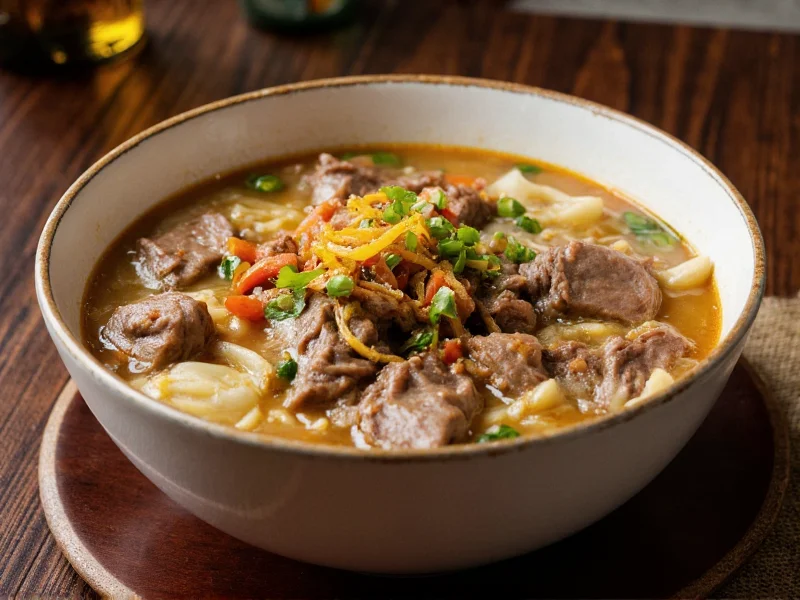Originating from northern China, particularly Beijing and Lanzhou regions, this beloved comfort food has evolved into numerous regional variations across Asia. The dish represents the perfect harmony of texture, flavor, and aroma that defines exceptional Chinese culinary tradition. What sets authentic braised beef noodle soup apart from simpler beef soups is the meticulous preparation process that develops layers of umami richness through careful spice selection and extended cooking time.
The Cultural Significance of Braised Beef Noodle Soup
Braised beef noodle soup, known as hong shao niu rou mian in Mandarin, holds cultural importance that extends beyond mere sustenance. In Chinese culinary tradition, the dish symbolizes patience and care in cooking—qualities highly valued in Chinese culture. The lengthy preparation process reflects the philosophy that worthwhile things require time and attention.
Historically, this dish emerged as a practical solution for making tough cuts of beef tender and flavorful. Northern Chinese communities, where beef consumption was more common than in other regions, developed this technique to maximize the potential of available ingredients. Over time, it evolved from peasant food to a beloved national dish enjoyed across social classes.
Essential Ingredients for Authentic Flavor
The magic of braised beef noodle soup lies in its carefully balanced ingredients. While regional variations exist, certain components remain essential for achieving that signature depth of flavor:
| Ingredient Category | Key Components | Function in Dish |
|---|---|---|
| Beef Selection | Chuck roast, shank, or brisket | Provides rich flavor and becomes tender during braising |
| Broth Foundation | Beef bones, water, aromatics | Creates the base for deep umami flavor |
| Core Spices | Star anise, cinnamon, Sichuan peppercorns, cloves | Provides distinctive aromatic profile |
| Flavor Enhancers | Soy sauce, rock sugar, ginger, garlic | Balances saltiness, sweetness, and depth |
| Noodles | Hand-pulled wheat noodles | Traditional base that absorbs broth flavors |
Step-by-Step Preparation Guide
Creating authentic braised beef noodle soup requires attention to detail at each stage. Here's a professional approach to achieve restaurant-quality results at home:
1. Selecting and Preparing the Beef
Choose well-marbled cuts like chuck roast or shank for optimal results when making homemade braised beef noodle soup. Cut the beef into 1.5-inch cubes, removing excess fat but retaining some for flavor. For the best texture in traditional Chinese braised beef noodle soup, blanch the beef first by boiling for 3-5 minutes, then rinsing under cold water to remove impurities.
2. Building the Flavor Foundation
The secret to exceptional braised beef noodle soup lies in the "master stock" technique. Start by stir-frying ginger and garlic in oil until fragrant, then add the beef to sear on all sides. This Maillard reaction creates complex flavor compounds essential for rich braised beef noodle soup broth. Add rock sugar and continue cooking until it caramelizes slightly, coating the beef pieces.
3. The Braising Process
Pour in sufficient water to cover the beef by 2 inches, along with soy sauce (both light and dark varieties), Shaoxing wine, and your spice bundle. Bring to a gentle boil, then reduce to the lowest possible simmer. The ideal braising beef noodle soup cooking time ranges from 2.5 to 3.5 hours—long enough for connective tissues to break down completely but not so long that the meat becomes dry.
For optimal results when making braised beef noodle soup, maintain a bare simmer—bubbles should barely break the surface. Skim any foam that appears during the first 30 minutes. The broth should reduce by about one-third, concentrating flavors without becoming overly salty.
Regional Variations Across Asia
While the Beijing-style version remains most recognized internationally, braised beef noodle soup has evolved distinct regional interpretations:
- Lanzhou Beef Noodle Soup: Features hand-pulled noodles in clear broth with thinly sliced beef, though it differs from traditional braised versions
- Taiwanese Braised Beef Noodle Soup: Often includes preserved vegetables and a slightly sweeter profile
- Sichuan Style: Incorporates chili oil and more Sichuan peppercorns for numbing heat
- Shanghai Variation: Uses more rock sugar for a darker, sweeter broth with a glossy finish
Pro Tips for Perfect Braised Beef Noodle Soup
Professional chefs emphasize these often-overlooked techniques when preparing authentic braised beef noodle soup:
- Spice preparation: Briefly toast whole spices before use to enhance their aromatic compounds—this makes a significant difference in traditional Chinese braised beef noodle soup flavor development
- Salt timing: Add salt only during the final hour of cooking to prevent toughening the meat fibers
- Noodle selection: Use fresh, chewy wheat noodles that can stand up to the rich broth without becoming mushy
- Resting period: Let the soup sit overnight; the flavors deepen considerably as the components marry
- Broth clarity: For restaurant-quality presentation, strain the broth through cheesecloth after cooking
Serving Traditions and Accompaniments
In China, braised beef noodle soup is traditionally served in wide, shallow bowls that allow the noodles to spread out. The proper assembly sequence matters: noodles first, then broth, followed by arranged beef pieces. Common accompaniments include:
- Blanched Chinese broccoli or bok choy
- Chili oil for those who prefer heat
- Chopped scallions for freshness
- Preserved mustard greens for tanginess
- Black vinegar for brightness
The ideal serving temperature for braised beef noodle soup is piping hot—around 160-170°F (70-75°C)—which maximizes aroma release and creates the most satisfying eating experience.
Storage and Reheating Best Practices
One advantage of braised beef noodle soup is that it often tastes better the next day as flavors continue to meld. For proper storage:
- Cool the soup quickly by placing the pot in an ice bath
- Store broth and beef separately from noodles to prevent sogginess
- Refrigerate for up to 4 days or freeze for 3 months
- When reheating, bring to a gentle simmer but avoid boiling to preserve texture
For meal prep enthusiasts making weekly braised beef noodle soup, consider preparing the broth and beef in larger batches, then portioning with fresh noodles when serving.











 浙公网安备
33010002000092号
浙公网安备
33010002000092号 浙B2-20120091-4
浙B2-20120091-4